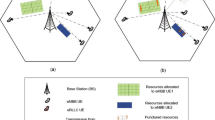Abstract
Due to the random deployment and the decreasing coverage of numerous base stations (BSs), the interference, including co-tier interference and cross-tier interference, is increasingly severe in ultra-dense networks (UDNs), which has negative effects on the communication quality. Considering all types of interference, we propose an interference management scheme aiming at maximizing the system capacity by jointly interference graph based clustering algorithm, suboptimal heuristic algorithm and ordered successive interference cancellation (OSIC) detection algorithm for UDNs. The analysis and simulations show that the average capacity and spectral efficiency of the proposed scheme have been improved compared with the optimal femto base stations subchannel allocation (OFBSSA) scheme and cluster-based FBS subchannal allocation (CFBSSA) scheme. The results also verify that the proposed scheme outperforms these two schemes in the following network scenarios: plenty of users located in overlapping region, a great many FBSs located in overlapping region, numerous FBSs and a large amount of users with random distributions, and it owns preponderances in meeting the requirements of 5G communication.








Similar content being viewed by others
References
Bhushan N, Li J, Malladi D, Gilmore R, Brenner D, Damnjanovic A, Sukhavasi RT, Patel C, Geirhofer S (2014) Network densification: the dominant theme for wireless evolution into 5G. IEEE Commun Mag 52(2):82–89
Zhao J, Ni S, Gong Y, Zhang Q (2019) Pilot contamination reduction in TDD-based massive MIMO systems. IET Commun 13(10):1425–1432
Wang B, Gao F, Jin S, Lin H, Li GY (2018) Spatial and frequency wideband effects in millimeter-wave massive MIMO systems. IEEE Trans Signal Processing 66(13):3393–3406
Zhao J, Liu Y, Gong Y, Wang C, Fan L (2018) A dual-link soft handover scheme for C/U plane split network in high-speed railway. IEEE Access 6:12473–12482
Ge X, Tu S, Mao G, Wang C, Han T (2016) 5G ultra-dense cellular networks. IEEE Wireless Commun 23(1):72–79
Shgluof I, Ismail M, Nordin R (2017) Semi-clustering of victim-cells approach for interference management in ultra-dense femtocell networks. IEEE Access 5(99):9032–9043
Zhang X, Su Z, Yan Z, Wang W (2013) Energy-efficiency study for two-tier heterogeneous networks (HetNet) under coverage performance constraints. Mobile Networks and Applications 18(4):567–577
Zhou Y, Liu L, Du H, Tian L, Wang X, Shi J (2014) An overview on intercell interference management in mobile cellular networks: From 2G to 5G. In: 2014 IEEE International Conference on Communication Systems (ICCS), Macau, pp 217–221
Ni S, Zhao J, Yang HH, Gong Y (2019) Enhancing downlink transmission in MIMO HetNet with wireless backhaul. IEEE Trans Veh Technol 68(7):6817–6832
Lopez-Perez D, Guvenc I, Roche GDL, Kountouris M, Tony QSQ, Zhang J (2011) Enhanced intercell interference coordination challenges in heterogeneous networks. IEEE Wireless Commun 18(3):22–30
Kaimaletu S, Krishnan R, Kalyani S, Ramamurthi B (2011) Cognitive interference management in heterogeneous femto-macro cell networks. In: 2011 IEEE International Conference on Communications (ICC), Kyoto, pp 1–6
Zhao J, Yang T, Gong Y, Wang J, Fu L (2013) Power control algorithm of cognitive radio based on non-cooperative game theory. China Commun 10(11):143–154
Hosseini K, Dahrouj H, Adve R (2012) Distributed clustering and interference management in two-tier networks. In: 2012 IEEE Global Communications Conference (GLOBECOM), Anaheim, pp 4267–4272
Abdelnasser A, Hossain E, Dong IK (2014) Clustering and resource allocation for dense FBSs in a two-tier cellular OFDMA network. IEEE Trans Wireless Commun 13(3):1628–1641
Wei R, Wang Y, Zhang Y (2014) A two-stage cluster-based resource management scheme in ultra-dense networks. In: 2014 IEEE International Conference on Communications in China (ICCC), Shanghai, pp 738–742
Hatoum A, Langar R, Aitsaadi N, Boutaba R (2014) Cluster-based resource management in OFDMA femtocell networks with QoS guarantees. IEEE Trans Veh Technol 63(5):2378–2391
Liang L, Wang W, Jia Y, Fu S (2016) A cluster-based energy-efficient resource management scheme for ultra-dense networks. IEEE Access 4:6823–6832
Dai J, Wang S (2016) Clustering-based interference management in densely deployed femtocell networks. Digital Communications and Networks 2(4):175–183
Nam W, Bai D, Lee J, Kang I (2014) Advanced interference management for 5G cellular networks. IEEE Commun Mag 52(5):52–60
Chang Y, Tao Z, Zhang J, Kuo JCC (2008) A graph-based approach to multi-cell OFDMA downlink resource allocation. In: 2008 IEEE Global Telecommunications Conference, New Orleans, pp 1–6
Tang S, Sun C, Wang J (2015) Interference management based on cell clustering in 5G systems. Telecommunication Engineering 55(11):1206–1211
Acknowledgements
This work was supported by the Fundamental Research Funds for the Central Universities (No. 2019YJS009), the National Natural Science Foundation of China (61661021), the Beijing Natural Science Foundation (L182018), National Science and Technology Major Project of the Ministry of Science and Technology of China (2016ZX03001014-006), the Open Research Fund of National Mobile Communications Research Laboratory, Southeast University (No. 2017D14), Jiangxi Provincial Cultivation Program for Academic and Technical Leaders of Major Subjects (20172BCB22016), the Key Technology Research and Development Program of Jiangxi Province (20171BBE50057).
Author information
Authors and Affiliations
Corresponding author
Additional information
Publisher’s Note
Springer Nature remains neutral with regard to jurisdictional claims in published maps and institutional affiliations.
Rights and permissions
About this article
Cite this article
Yang, L., Zhao, J., Gao, F. et al. Cluster-Based Joint Resource Allocation with Successive Interference Cancellation for Ultra-Dense Networks. Mobile Netw Appl 26, 1233–1242 (2021). https://doi.org/10.1007/s11036-019-01368-7
Published:
Issue Date:
DOI: https://doi.org/10.1007/s11036-019-01368-7




